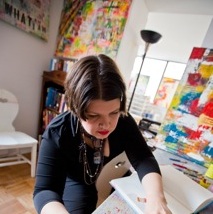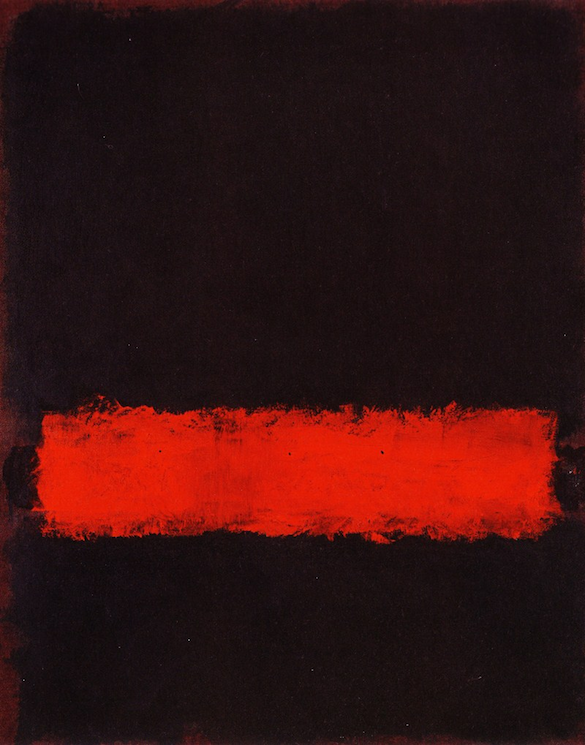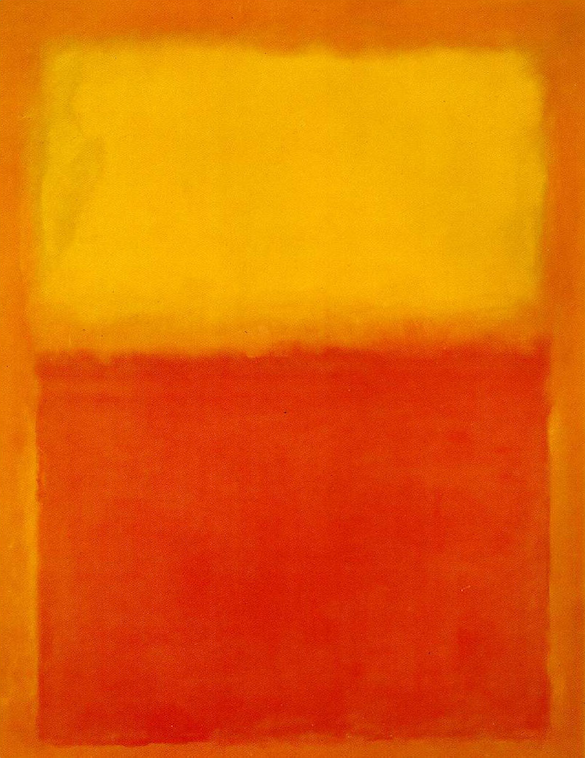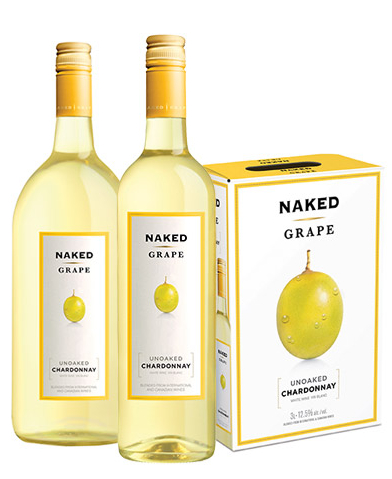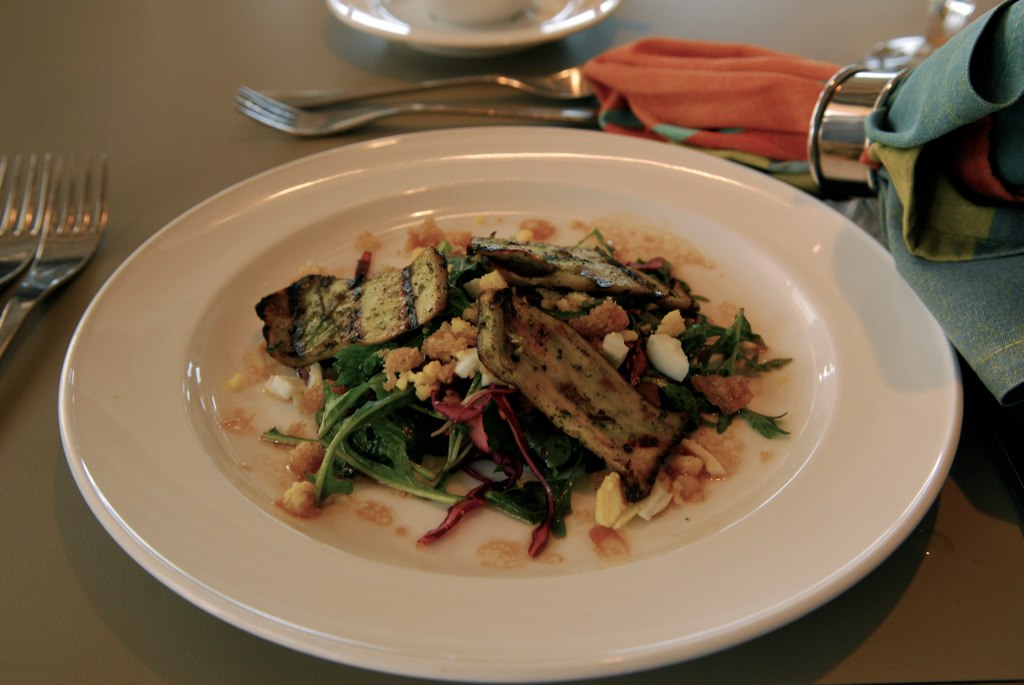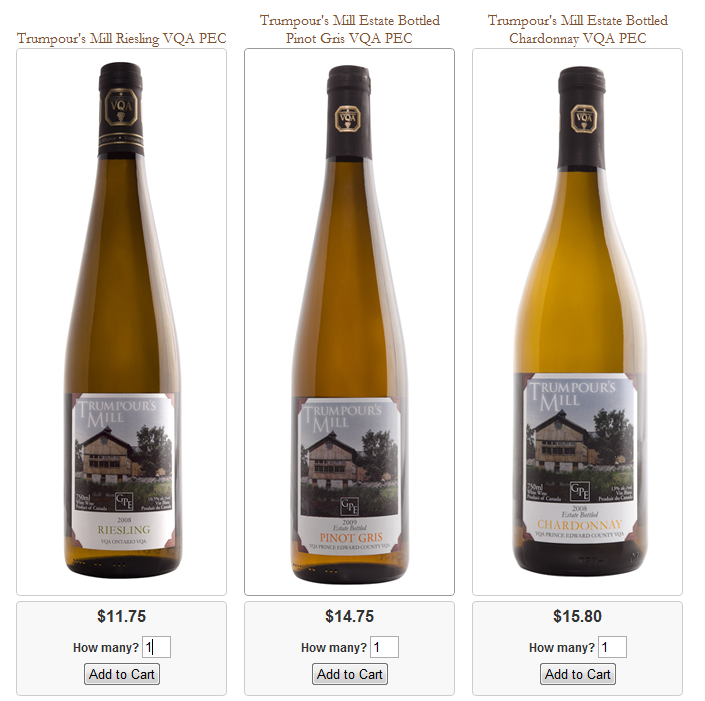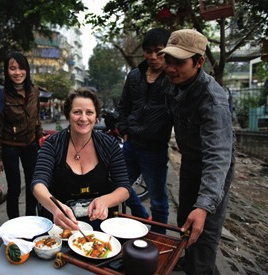Wine and Art is a new series by longtime GFR contributor and exhibited visual artist Lorette C. Luzajic. Beyond the wine and cheese served at every gallery show opening, Lorette finds the connection between great artists and what’s in the glass, and offers her personal view of what works best when contemplating the canvas. – Malcolm Jolley, Ed.
What a way to go – the way all artists want to go – alone, at work, in studio.
He had taken pills, but just to be sure, he’d slit an artery on his arm. He was found dead in a six foot by eight foot puddle of congealed blood, his last masterpiece, a grim finale.
Characteristically, there was no suicide note. Untitled.
Rothko’s last drama was simple, yet epic, like his canvases. He painted gargantuan swathes of colours, blending two or three rectangles to hover over an expanse of space. All of his works were titled “Untitled”, but this simplicity caused great complications later. (Just try Googling “Mark Rothko, Untitled” and you’ll see what I mean.) Rothko’s art showed, in his own words, “clarity, the… elimination of all obstacles between the painter and idea, and idea and observer.”
Even the artist’s name was pared back to its purest essence: Mark Rothko from Marcus Yakovlevich Rothkowitz. Born in now-Latvia in 1903, fleeing to America for freedom from then Russia, Rothko resisted labels like “abstract painter” and “abstract expressionism.”
Going still further beyond abstract, Rothko pursued pure nothingness in his paintings. Columbia Museum curator Will South told the New York Times, “Once everything is stripped away, all you’re left with is emotion.”
A mercurial and dark painter like Mark Rothko, whose paintings command millions, seems an odd choice to contemplate while sipping the bright and buoyant Naked Grape Wines. These cheap and cheerful beauties enliven anyone’s table. But Naked Grape’s unpretentious simplicity might be a perfect example of what the artist sought in his work. The brand’s straightforward and easygoing elegance is a good example of the spiritual modernism Rothko pursued.
Naked Grape wines let the product do the talking. Their website carries little information about the brand, inviting you to try it for yourself. The unconventional decision to derobe the grape of oak barrel aging traditions, making them “naked” grapes, sets the wine apart from other brands and lets the fruit speak for itself. This approach seems radical to those whose palates expect “oakiness” for “complexity” and “sophistication,” but aren’t aware the process can be a mask for wine that can’t stand on its own. Winemaker Randall Grahm said famously, “People who think of oak as a primary flavour in wine also tend to think of ketchup as a vegetable.”
Ouch.
Natalie MacLean also mentioned in Red, White, and Drunk All Over that oak is “considered by many winemakers to the ketchup of the wine world, its strong flavour masking flaws or making up for lack of character.”
Personally, I wouldn’t go that far. I love ketchup, for one thing. For another, I adore the heady, smoky, vanilla-tinged wines as much as everything else. And I love cornucopia paintings, with abundant details and narratives, the Bruegels and the Boschs, the Rauschenberg collages, the paintings of salons full of paintings. Spicy wines that taste like cake and barbecue at the same time are part of that splendid muchness.
Still, on a Tuesday autumn afternoon in my window ledge, looking down at the bustle of the city, I am grateful for this bit of clarity in a glass, crystal cold and distilled to its essence. Pared back. The end of today’s sunlight illuminates the brilliant orange leaves below and I keep poring over Rothko’s oranges. You need to see Rothko’s original works for their full impact; this is especially so with this artist’s paintings. They are massive. Their presence is an important part of the experience. Still, one can daydream in a dazzling November daze fueled by Chardonnay.
Naked’s Chardonnay is a revelation. Chardonnay’s overwhelming bouquet is not everybody’s favourite guest, but as soon as that oakiness is pulled back and the grape is left alone, the scent is clean and gorgeous.
The off-dry Naked Grape Luscious Red could unkindly be called plonk, but it’s big and bold and delicious, the Red Velvet cupcake of wine.
The rest of the Naked line surprises without fireworks, without razzle dazzle, without ostentation. There is other wine – better wine, fancier wine, wine with chocolate and leather and horsey mouthfuls. But there are occasions when a 20 dollar bill must split in half for two good bottles; there is a time for the grape to stand alone beside a stark Parmesan or the violent perfume of blue cheese. There is a time to stand bare naked, stripped to one’s essentials.
Perhaps this is what the contemplation of Rothko’s work demands: a reflection on what it means to be stripped essential. Without pictures, without symbols, without any identifiable cues, how can we look at art? What can we look for? Rothko said he was only interested in “expressing basic human emotions- tragedy, ecstasy, doom, and so on.”
Writers often call Rothko’s work “spiritual,” and his art is more often paired with meditation than with wine. The poet Stanley Kunitz called him “the last rabbi in Western art.” (How many were there?) Edward Van Voolen’s 50 Jewish Artists You Should Know uses words like “hermetic” and says Rothko’s work may be “hinting to a divine presence.” He compares vast “mysteriously dark paintings” to nothing less than “the curtain separating the Holy of Holiest in the desert tabernacle of the Jerusalem Temple from the rest of the sacred spaces.”
On the other hand, PBS’s David E. Anderson quotes from the London Times, an unnamed vicar. “For me the paintings are the tablets of stone of Mount Sinai, but with the commandments lost. They are icons of the absence of God.”
I think the questions of essence or of simplicity or of faith- or it’s absence- can best be seen in Rothko’s work as one question. As Rothko’s son once told the New York Times, “He’s asking the big questions: Why are we here, and what does it mean to be alive?”
You can’t get more naked than that. Not even a tumultuous real life or a gruesome curtain call can take away from the essential and elegant question of being.
Perhaps Rothko’s search for meaning can be distilled into a few lines from a poem. It is from Sam Hamill’s collection Destination Zero, and used by a Naked Grape Winery in Oregon (whose wines are no relation to these Naked Grapes and whose wines I have never tried.)
It’s enough to have
a few days naked
among three hundred kinds of rain.
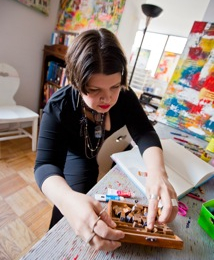 Lorette C. Luzajic is an artist and writer with roots in southern Ontario’s wine country soil. Native to Niagara, at home in Toronto, her work is inspired by wine, cheese, and bleak post-apocalyptic literature. If you missed her at the ROM or the Ritz, visit her at ideafountain.ca. Photo: Ralph Martin.
Lorette C. Luzajic is an artist and writer with roots in southern Ontario’s wine country soil. Native to Niagara, at home in Toronto, her work is inspired by wine, cheese, and bleak post-apocalyptic literature. If you missed her at the ROM or the Ritz, visit her at ideafountain.ca. Photo: Ralph Martin.

